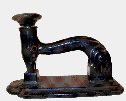The Old CATV Equipment Museum
Links
Museums: Other Stuff
 American Museum of Photography American Museum of Photography
http://www.photographymuseum.com/
The Museum is a private volunteer effort that currently receives no financial support from any government agency or foundation.
 BE-CALC BE-CALC
http://www.devidts.com/be-calc/
It could be hard to imagine the kind of work and energy that once was invested in the development of electronic calculating devices.
 Classic Typewriter Page Classic Typewriter Page
http://staff.xu.edu/~polt/typewriters/tw-history.html
The concept of a typewriter dates back at least to 1714, when Englishman Henry Mill filed a vaguely-worded patent for "an artificial machine or method for the impressing or transcribing of letters singly or progressively one after another." But the first typewriter proven to have worked was built by the Italian Pellegrino Turri in 1808 for his blind friend Countess Carolina Fantoni da Fivizzono.
 Early Electronic Calculator Technology Reference Early Electronic Calculator Technology Reference
http://people.cs.ubc.ca/~hilpert/eec/
A source of information about the technology used in the construction of early electronic calculators.
 Early Office Museum Early Office Museum
http://www.officemuseum.com/
The Early Office MuseumTM engages in research on the history and evolution of offices, antique office machines and equipment, and business technology based on original documents, artifacts, and vintage photographs.
 Global Positioning System Global Positioning System
http://www.gps.gov/
The Global Positioning System (GPS) is a U.S.-owned utility that provides users with positioning, navigation, and timing (PNT) services. This system consists of three segments: the space segment, the control segment, and the user segment. The U.S. Air Force develops, maintains, and operates the space and control segments.
 Historical Electronics Museum Historical Electronics Museum
http://www.hem-usa.org/
From telegraph and radio to radar and satellites, the HEM offers visitors free access to the electronic marvels that have helped to shape our country and our world.
 History of the Electric Power Industry History of the Electric Power Industry
http://www.eei.org/whoweare/AboutIndustry/Pages/History.aspx
America enjoys some of the most reliable and affordable electricity in the world. But have you ever wondered how today's electricity system, with its "on-demand" power, got its start?
 History of the Incandscent Lamp History of the Incandscent Lamp
http://invsee.asu.edu/Modules/lightbulb/meathist.htm
The invention of the incandescent light bulb has a history spanning from the early 1800s. Until that time, available light sources consisted of candles, oil lanterns, and gas lamps. In 1809, an English chemist, Humphrey Davy, started the journey to the invention of a practical incandescent light source. He used a high power battery to induce current between two charcoal strips
 History of the Transistor History of the Transistor
http://www.sjsu.edu/faculty/watkins/transist.htm
The crucial component of an electronic device is a controllable valve that lets a weak signal control a much larger flow much as a faucet controls the flow of water. At one time the controllable valve used in electronic circuits was the vacuum tube. The vacuum tube worked but it was bulky and used a lot of electrical power that ended up as heat which shortened the life of the tube itself. The transistor was a much more elegant solution to the needs of electronics. The transistor is small and uses much, much less power than the vacuum tube. Because it uses so little power there is little heat to dissipate and the transistor does not fail so quickly as does a vacuum tube.
 Hyperbolic Radionavigation Systems Hyperbolic Radionavigation Systems
http://jproc.ca/hyperbolic/
This web page is intended to review hyperbolic radionavigation systems of the past and at least one current system, namely Loran-C. The systems featured here are specific to my area of interest.
 IEEE Virtual Museum IEEE Virtual Museum
http://www.ieeeghn.org/wiki/index.php/Main_Page
Welcome to the IEEE Virtual Museum! The IEEE is the Institute of Electrical and Electronic Engineers, a non-profit, technical professional association of more than 350,000 individual members in 150 countries. Through its members, the IEEE is a leading authority in technical areas ranging from computer engineering, biomedical technology and telecommunications, to electric power, aerospace and consumer electronics, among others.
 Insulator Collectors On the Net Insulator Collectors On the Net
http://www.insulators.info/
Glass insulators were first produced in the 1850's for use with telegraph lines. As technology developed insulators were needed for telephone lines, electric power lines, and other applications. In the mid 1960s a few people began collecting these antique insulators. Today there are over 2000 collectors. Insulator clubs, local and national shows, and good reference books are available.
 Kaprekar's operation Kaprekar's operation
http://www.file22.com/81.html
The number 6174 is a really mysterious number. At first glance, it might not seem so obvious. But Kaprekar's operation uncovers the mystery that makes 6174 so special.
 Military Radios - Spy Radios - Tubes Military Radios - Spy Radios - Tubes
http://www.radiomilitari.com/
Personal Museum of Military Radios, Spy Radios and Tubes, by Antonio Fucci Fano (in Italian).
 Mister Transistor's Historic Semiconductors Mister Transistor's Historic Semiconductors
http://homepages.nildram.co.uk/~wylie/history.htm
This part of my Website is about a longstanding hobby interest of mine: old semiconductor devices, particularly transistors. Click my 'transistor history' button on the left to find historical information and fascinating images of lots of weird devices from the 1950's and 1960's. Use the button for 'related sites' to find other Web resources on a similar theme, including those about semiconductor history and about early transistor radios.
 Museum of Unworkable Devices Museum of Unworkable Devices
http://www.lhup.edu/~dsimanek/museum/unwork.htm
This museum is a celebration of fascinating devices that don't work. It houses diverse examples of the perverse genius of inventors who refused to let their thinking be intimidated by the laws of nature, remaining optimistic in the face of repeated failures.
 Old Insulators Old Insulators
http://oldinsulators.com/
Welcome to Old Insulators, one of the most entertaining and informative Insulator Collecting Hobby web properties on the Internet. After 30 years in this great hobby I am still and always interested in hearing from you.
 Railroad Signals.net Railroad Signals.net
http://railroadsignals.net/
Preserving America's Signaling Past. This site features my collection of railroad signals, signs, and lanterns.
 Robert Goddard Museum Robert Goddard Museum
http://www.galenfrysinger.com/new_mexico_goddard.htm
Robert Hutchings Goddard, Ph.D. (1882-1945), U.S. professor and scientist, was a pioneer of controlled, liquid-fueled rocketry. He launched the world's first liquid-fueled rocket on March 16, 1926. From 1930 to 1935 he launched rockets that attained speeds of up to 885 km/h (550 mph). Though his work in the field was revolutionary, he was sometimes ridiculed for his theories. He received little recognition during his lifetime, but would eventually come to be called one of the fathers of modern rocketry for his life's work.
 Signalfan's Museum of Traffic Control Signalfan's Museum of Traffic Control
http://signalfan.com/
This site is devoted to the unusual hobby of legally collecting old, retired traffic signals and road signs. It is a way of preserving the past and to restore to life the traffic control devices that have helped shape our modern world. Hopefully, the information contained here can help people to gain a better understanding as to the differences, as well as the similarities and standards of design and practice. Plus, signals and signs are just plain fun to collect and display!
 Sparkmuseum Sparkmuseum
http://www.sparkmuseum.com/
Antique Wireless and Scientific Instruments from the collection of John D. Jenkins
 Telegraph-History Telegraph-History
http://www.telegraph-history.org/
This site contains several articles that focus on U.S. Telegraph-History. The majority of these articles first appeared in the "Key and Telegraph" column of "The AWA Journal," the quarterly magazine of the Antique Wireless Association.
 Telegraphy: A Short History. Telegraphy: A Short History.
http://samhallas.co.uk/telhist1/
A talk prepared for the RSGB Data Symposium in 1987. Presented as three short articles with plenty of illustrations. Extra pictures added and existing ones made bigger November 1999.
 Total Rewing: Virtual Museum of Vintage VCRs Total Rewing: Virtual Museum of Vintage VCRs
http://www.totalrewind.org
This museum explores the surprising history of the humble video recorder. You probably know that there was another kind of video, called Betamax, which was eventually beaten by the VHS system we all use today. But do you remember Video 2000? And did you know that this "Format War" was actually the closing chapter in a long and complex story, with many wrong turns and blind alleys?
 U.S. Army Ordnance Museum U.S. Army Ordnance Museum
http://www.ordmusfound.org/
The Ordnance Museum traces its origin back to the Calibre Board which was convened in France on 11 December 1918, under BG Westervelt. The mission of the Calibre Board, or Westervelt Board as it is sometimes known, was to evaluate the lessons learned in World War I in regard to the use of artillery and to make recommendations concerning future policies pertaining to its development by the U.S. Army.
 v2rocket.com v2rocket.com
http://www.v2rocket.com/
This is the A-4/V-2 Resource Site. It is devoted to one of the most awesome weapons of WWII - the V-2 rocket. The V-2 or Aggregat 4, was the first long-range ballistic missile to be actively used in combat. This huge German rocket hurtled a one-ton warhead 50 miles high and hundreds of miles down range to its target. This site will try to give you an accurate account of the design, production and combat deployment of this weapon during World War II.
 Vintage Calculator Web Museum Vintage Calculator Web Museum
http://www.vintagecalculators.com/
A celebration of old calculators showing the evolution from mechanical calculator to pocket electronic calculator.
 Waymarking Waymarking
http://www.waymarking.com/
Waymarking is a way to mark unique locations on the planet and give them a voice. While GPS technology allows us to pinpoint any location on the planet, mark the location, and share it with others, Waymarking is the toolset for categorizing and adding unique information for that location.
|
|
